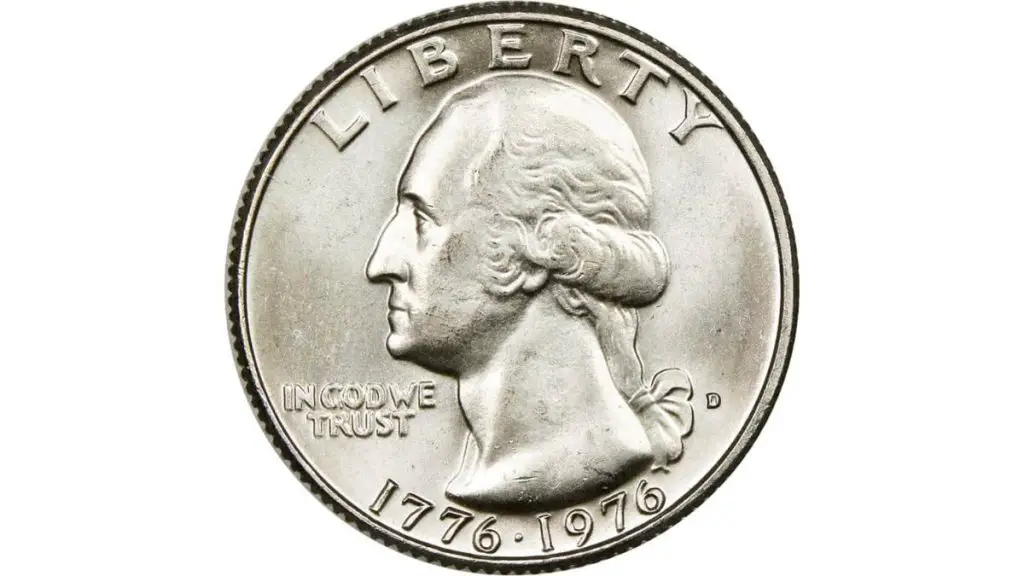Also known as the bicentennial quarter, the 1776 to 1976 quarter dollar holds much sentiment to collectors and investors alike. So, whether you are interested in this coin for historical sentiments, find it visually appealing or need to know if it will make you huge bucks in the coin market with this coin, read on.
In the numismatic world, the value of the 1776 to 1976 dollar depends on several factors, including mint condition, errors, and rarity.
In this piece, we will bring all you need to know about the 1776 to 1976 quarter dollar value to light. You’ll learn how to estimate this coin’s value and learn details about existing errors, history, and varieties.
1776 to 1976 Quarter Dollar Value Chart
The table below captures different varieties of the 1776 to 1976 quarter dollar. It highlights their prices as determined by the coin’s grade.
| Mint Mark | MS 60 | MS 63 | MS 66 | MS 69 |
| 1776 – 1976 Clad No Mint Mark Quarter | – | $4 | $55 | $4350 |
| 1776 – 1976 Clad “D” Mint Mark Quarter | – | $4 | $60 | – |
| 1776 – 1976 “S” Clad Quarter (Proof) | $5 | $6 | $8 | $35 |
| 1776 – 1976 “S” Silver Quarter | $6 | $6 | $18 | $9250 |
| 1776 – 1976 1776 – 1976 “S” Silver Quarter (Proof) | $3 | $4 | $13 | $34 |
When you find a 1776 – 1976 Washington quarter in circulated condition, it is valued at its face value of 25 cents.
In addition to this, most bicentennial quarters are worth at least $5 if found in mint state. They could be worth more if they have rare errors that increase their value. However, if you lay your hands on any of the 1776 to 1976 quarters, a close estimate of the value of your coin can be determined using this coin value checker.
The History of the 1776 to 1976 Quarter Dollar?
The Bicentennial quarter has much history attached to its making. It is called the bicentennial quarter because it was minted to mark the 200th anniversary of the signing of the Declaration of Independence in America. In addition to this, it is also one of the most common commemorative coins issued in the 1970s to mark celebrations.

This quarter was only minted in 1975 and 1976 in large numbers, and they were abundant in circulation because production started a year early. This decision was made to discourage people from hoarding the coin. However, it was still coveted and sought after due to its unique design and historical significance.
Even though the coin was minted in 1975 and 1976, it carries the dual dates 1776 – 1976. When the unique coin was released, no other coins of the same denomination bore the single date of 1975 or 1976.
Unique Features of The Bicentennial Quarter
The 1776 to 1976 quarter dollar was minted in separate compositions. Denver and Philadelphia mints produced copper and nickel coins, while San Francisco produced 40% silver coins.
Here are some features of the coin that make it a popular favorite;
The Obverse
The obverse side of the 1776 to 1976 bicentennial quarter features a portrait of the first president of the United States of America, George Washington. In the picture, the ex-president’s hair is pulled back in a ponytail, a common hairdo men often wore in that era.
The dual dates 1776 – 1976 also appear on this side, along with the inscriptions “LIBERTY” AND “IN GOD WE TRUST.” The word “LIBERTY” is inscribed on the upper rim above George Washington’s head, while “IN GOD WE TRUST” is in front of his profile, on the left side.
Finally, the mint mark of the coins can be found behind the profile, close to the right edge. All 1776 – 1976 bicentennial coins feature this mint mark, except those from Philadelphia, on which they are absent. John Flanagan designed this obverse side of the coin.
The Reverse
On the reverse side of the 1776 to 1976 quarter dollar, you can see the image of a revolutionary boy soldier, also known as a colonial patriot playing the drum. You can also see a victory torch surrounding the drummer, with thirteen stars close to the upper left side of the coin.
The reverse side of this bicentennial coin features an inscription of the motto “E PLURIBUS UNUM,” “UNITED STATES OF AMERICA,” and “QUARTER DOLLAR.” Jack L. Ahr put together this historic reverse design. The famous image of the colonial drummer led to this 1776 -1976 quarter dollar being fondly referred to as “The drummer boy quarter.”
1776 to 1976 Penny Details
- Coin Series: Washington Bicentennial Quarters
- Year: 1976
- Total Mintage: 1,691,961,954
- Obverse Designer: John Flanagan
- Reverse Designer: Jack L. Ahr
- Mint Location: Philadelphia, San Francisco, and Denver
- Composition: 91.67% Copper – 8.33% Nickel or 80% Silver – 20% Copper
- Diameter: 24.3 mm
- Weight: 5.67 grams
- Edges: Reeded
- Melt value: $0.0545 for (91.67% Copper – 8.33% Nickel) and $1.7880 for (80% Silver – 20% Copper)
Other features of this coin include a weight of 5.67g and a diameter of 24.3mm. The thickness borders on 1.75mm.
Variants of The 1776 – 1976 Quarter Dollar
This bicentennial quarter dollar produced in 1975 and 1976 has three varieties. This includes those made in the Philadelphia Mint, the Denver Mint, and the San Francisco Mint.
Depending on the composition, these variants are also divided into type 3 and type 4 designs, where type 3 is for those composed of clad and type 4 is for those made from silver.
| Mint Mark | Mintage | Auction Record |
| 1776 – 1976 Clad No Mint Mark Quarter | 809,784,016 | $1821 |
| 1776 – 1976 Clad “D” Mint Mark Quarter | 860,118,839 | $6463 |
| 1776 – 1976 “S” Clad Quarter (Proof) | 7,059,099 | $6,038 |
| 1776 – 1976 “S” Silver Quarter | 11,000,000 | $19,200 |
| 1776 – 1976 “S” Silver Quarter (Proof) 1776 – 1976 | 4,000,000 | $13,500 |
1776 – 1976 Bicentennial Quarter Dollar Errors?
The bicentennial coins were minted in large quantities of up to 1.7 billion. As such, errors are inevitable, as no minting process is perfect. Quarters found with some of these errors are valued at high rates.
Some of the errors that can be found on the 1776 to 1976 quarter dollar include:
1776 to 1976 Quarter Colonial Drummer Error
This happens when the coin is struck with grease from an old or dirty die, resulting in a poorly expressed drummer image.
The colonial drummer quarter error takes much experience to notice. However, if you know your coins well, it should be a walk in the park for you.
1776 to 1976 Quarter Overstruck Error
During the minting process, If a coin die presses over the wrong planchet, it leads to an overstruck quarter.
This error means you can find the dime design on a 1776 to 1976 quarter, making it even more valuable to collectors.
1776 to 1976 Quarter Dollar Doubled Die Error
A coin being struck on an improperly made die results in a doubled die. This means you can notice double inscriptions on either the obverse or reverse side, or even both. Some collectors are said to have found doubled die quarters valued at up to $3,300.
1776 to 1976 Quarter Dollar Off-center Obverse Error
When the planchet is positioned improperly during the minting process, it can result in a quarter with an off-center obverse. When this happens, the die strikes the coin accurately and moves the design to one side of the coin.
Depending on how much of the design is visible, an off-center obverse coin design can shift from 5% to 9%. Coins are usually valued more if the design percentage visible is small.
1776 to 1976 Quarter Dollar Struck Through Errors
If the design or pattern of the fabric used during minting appears on a coin, it could leave an imprint on the surface of the quarter and result in what is known as a struck-through quarter error. While this is unique, it is also one of the rarest errors in the 1776 to 1976 quarter dollar.
1776 to 1976 Bicentennial Quarter FAQs
Because of how interesting this quarter is, some speculations exist about its rarity and value. Here are some frequently asked questions concerning the coin:


